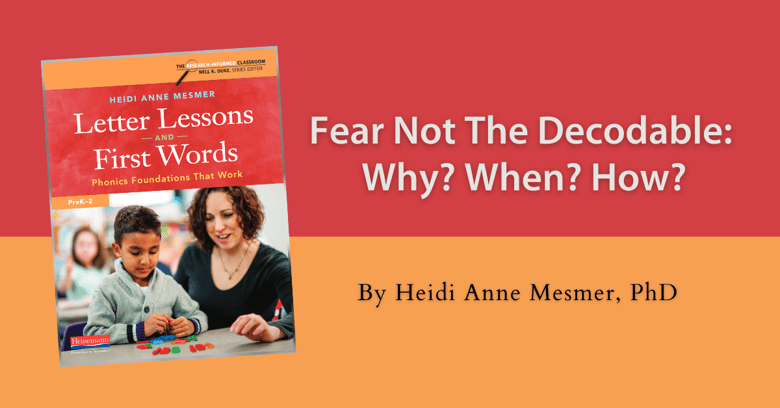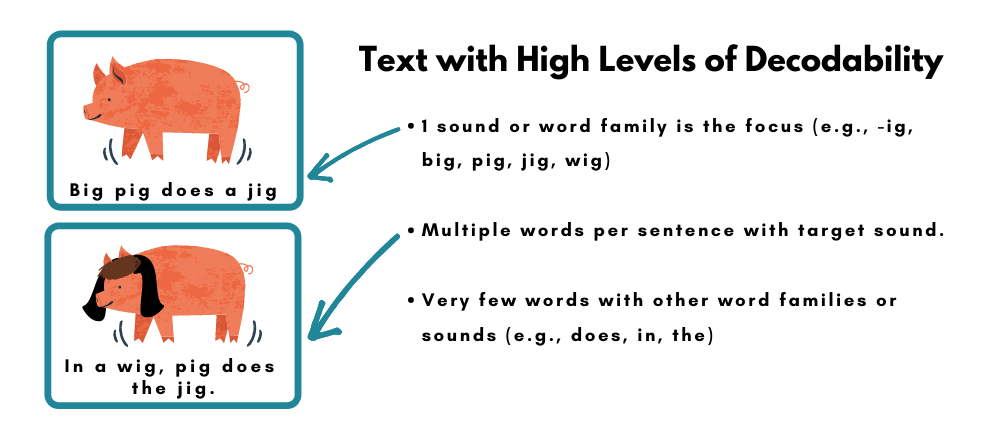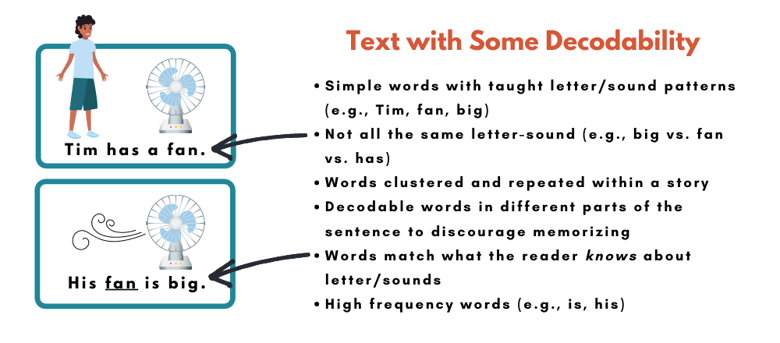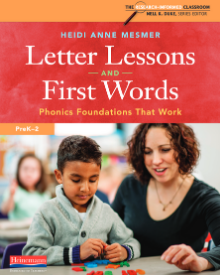 By Heidi Anne Mesmer, PhD
By Heidi Anne Mesmer, PhD
“Ugh! Are you kidding? Figs, pigs, wigs, and jigs! No thank you! Reading is about meaning and those dumb stories are stupid!” protested one first grade teacher when asked about decodable texts. “Decodables are essential! What good is it to teach kids to ‘sound things out’ if there are no words to sound out in text?” countered another teacher. “I need them to teach reading!” And so goes the typical conversation about decodable text, a worn-out love/hate relationship that seems to swing back and forth with the early literacy pendulum. But dwelling in hyperbole almost never helps kids, so I would like to suggest that we step back from extreme responses to take more a measured, middle-ground approach. In this blog, I’ll share my experiences and analysis of the research literature about what I think can be a limited, but useful, tool—decodable text. This blog will discuss what decodable text is, why it might be used, when, developmentally, it might be used, and how it can be used to boost early reading skills.
Decodable text is a type of beginning reading material in which the words have been controlled to contain letter-sounds and high frequency words that the learner has been taught (Mesmer, 2001). The idea with decodable texts is that the reader should be able to apply letter/sound knowledge to independently recognize words in text. Although there has been some attempt to ensure that decodable texts contain 80% of previously-taught words, close analyses have proved this percentage to be unattainable in most “decodable” materials (Foorman et al., 2004). Instead of thinking of books as “decodable” or “not decodable,” we simply consider the idea of “decodability” to vary on a continuum, with some books having words that are more or less decodable to certain readers. (See below.)
Why?
If you are like the first teacher above, you might be wondering why anyone would use decodable texts. There are three key reasons: (a) to bridge an important developmental transition in word reading, (b) to provide a field for the transfer of letter/sound knowledge to reading, and (c) to encourage and empower beginning readers to decode. What we know about word reading is that when readers use letter-sounds to figure out words, they then store those words cognitively through orthographic mapping and this allows them to later call up words by sight, automatically (Ehri, 2005). Therefore, if a child comes to the word “hot” many times and works to sound it out each time (i.e., h-o-t, hot!), he will eventually store that word and no longer need to sound it out. In addition, decoding in context also promotes reading new, unseen words (Share, 1995).
What does the research say?
The fact is that there are very few recent studies in which the effects of using any type of beginning reading texts have been systematically studied. That said, a recent research review consolidates current perspectives on texts with decodability and suggests some advantages to its use (Cheatham & Allor, 2012). Studies that have manipulated text decodability as an independent variable reveal that it prompts readers to use letter-sounds during connected reading (Juel & Roper/Schneider, 1985; Mesmer, 2001, 2005; Vadasy, Sanders, & Peyton, 2005). When students receive a heavy dose of highly decodable text, they emerge with robust decoding abilities and retain words they have read in text.
There are some caveats. In one study, two groups of first graders received one-on-one tutoring with the same scripted phonics curriculum but either more or less decodable text, and the type of text did not affect students (Jenkins, Peyton, & Sanders, 2004). Thus, a strong phonics curriculum delivered in 25 one-one sessions negates the impact of text. Other studies suggest there may be a fluency compromise in highly decodable texts (Mesmer, 2010).
Although they do not exclusively address decodability, several other text studies are useful. Researchers contrasted an uncontrolled literature-based program to one using texts designed on multiple criteria (e.g., decodability, repetition, high frequency words). After 15 weeks, first graders reading multi-criteria books outperformed those reading literature in word reading and reading level (Menon & Hiebert, 2005). In another study, a researcher used predictable big books to teach words in three different ways: (a) repeatedly reading the books (10 times over 4 days); (b) reading the words on sentence strips; and (c) analyzing the words individually. Students learned the least number of words through rereading and the most through individual analysis (Johnston, 2000).
When?
One of the reasons that people have concerns about decodable texts is that the question of when has not really been well addressed. When to use decodables is the most important consideration. I see decodable sets with hundreds of sequential books that stretch over an entire year. I do not think that is necessary at all. My reading of the research suggests that there is actually a very specific developmental window when decodables are useful.
I first discovered this material while working with a second grader who, after a year of one-on-one tutoring, was still reading at the very lowest levels. Despite having letter/sound knowledge, the child was actually using a “partial alphabetic” approach to reading words in books (Ehri, 2005; Mesmer, 1999). She would use beginning sounds along with pictures and memory to guess at words. The approach would have been fine in early first grade or late kindergarten but not in second grade. She needed to move into “full alphabetic” reading, or fully sounding out words—including the vowels. What I found was that the books I was using did not support this transition. She would come to words in text like “hair” and “grouchy,” and she did not have the knowledge to decode them. When I used texts with some decodability she began to use what she knew about letter-sounds to sound out words in text. It was empowering and amazing to the see “I can do it!’ smile spread across her face when she would pause at a tough word and work it out.
How?
Often when I discuss how to use decodables with teachers I get the kind of extreme responses described above (Never use decodables! Exclusively use decodables!). In my opinion, neither of these approaches is helpful. Instead, I offer the following recommendations about how to use decodables.
- Use at the right developmental point.
Decodables should be used once children are extremely solid with all letter-sounds and are ready to fully decode. They should have a solid concept of word and be able to accurately point to both single-syllable and multisyllabic words in a predictable text, using beginning sounds to help them. I suggest that children be able to decode a simple c-v-c word prior to using decodables. - Use after a phonics lesson to practice target word family or sound.
The most obvious time to ask children to read a decodable is right after a decoding lesson in which they have had instruction on a specific word family. When children see words they have decoded in text, they understand that the work they are doing has a real application. Put these books in children’s hands, let them do it! Let them read and reread these books. Have them “sound out” words. They should be able to do it all by themselves without a lot of “overscaffolded” instruction. - Do not use exclusively.
I do not recommend using decodables exclusively for two reasons. First, the sounding out that children have to do in a decodable is substantial and can be wearing. Second, there are other types of books that children benefit from, including multi-criteria texts like those mentioned above. Use decodables for their purpose—to practice decoding in context. - Pay attention to the level of decodability.
In reality, texts do not exactly fit into neat categories of “decodable” vs. “not-decodable.” Instead, decodability exists on a continuum, with some texts being more decodable and others being somewhat decodable. In the more decodable books, there is a really tight level of control with many words having specific letter/sound patterns.

You can usually spot these because there are lot of short vowel words and each sentence will offer many decoding opportunities. The page of this Bob Book is an example:
Dot had a dog. The dog is Mag.
Mag to the bag. Dot got Mag.
Notice that the –ot, -og, and –ag families are all represented throughout the sentence. To decode the first line of print, the reader has to shift between an –ot word (Dot) then an –og word (dog), then another –og word (dog) and then an –ag word (Mag), all in the first line of print.
I like to use books like this near the end of short vowel instruction, when readers have gotten pretty fluent with decoding short vowels and can handle these shifts pretty seamlessly. If you are using a decodable and the reader is slowing down at every third word to sound out, the book is likely not quite right.
At the beginning of decoding instruction where the focus is on word families and adding a beginning sound to a family, I like to use books that I call somewhat decodable. Below is an example:
I like to win.
I like to pin.
I like to sip.
I like to dip.
I like to hop.
I like to pop.
This is me!
All I can be!
In this example, there are decodable words, but they are at the end of each sentence. In order to read this book, the reader can use the repeated sentence and the high frequency word like, then do the decoding work at the end of the sentence. The decoding work is not too overwhelming, and the reader can apply letter/sound knowledge without taking too long to read the book.

- Know when to stop
I believe1 that decodables are most useful for propelling children through the period in which they are learning to decode words or blend sounds together. This period is usually 2-3 months. Once a child can quickly and easily blend c-v-c words with all short vowels, I believe they no longer need decodables. I would also add that these words should also include c-c-v-c words that contain consonant blends or digraphs (e.g. ship, plan). By the time fluid decoding of short vowel c-v-c words is accomplished, most children will have a reading vocabulary close to 500 words that will land them squarely in text levels nearing a mid-first or early second-grade level. Typically, this point will occur in spring of Kindergarten or fall/winter of first grade.
___________________________________________________________________
[1] Note: I am very purposefully using the word “believe” here.
• • •
 For more ideas and suggestions (e.g., How to do a Bookwalk in a Decodable) see Letter Lessons and First Words: Phonics Foundations that Work at Heinemann.com.
For more ideas and suggestions (e.g., How to do a Bookwalk in a Decodable) see Letter Lessons and First Words: Phonics Foundations that Work at Heinemann.com.
 Heidi Anne E. Mesmer, PhD, is a Professor in Literacy in the School of Education at Virginia Tech. A former classroom teacher, she works extensively with teachers, schools, and young readers, directing numerous school-based initiatives to improve reading instruction. Heidi Anne studies beginning reading instruction and text difficulty and her work has been published in The Reading Teacher, Reading Research Quarterly, The Educational Researcher, Elementary School Journal, and Early Childhood Research Quarterly. She is the author of Tools for Matching Readers to Texts, Reading Interventions in Primary Grades, and Teaching Skills for Complex Texts.
Heidi Anne E. Mesmer, PhD, is a Professor in Literacy in the School of Education at Virginia Tech. A former classroom teacher, she works extensively with teachers, schools, and young readers, directing numerous school-based initiatives to improve reading instruction. Heidi Anne studies beginning reading instruction and text difficulty and her work has been published in The Reading Teacher, Reading Research Quarterly, The Educational Researcher, Elementary School Journal, and Early Childhood Research Quarterly. She is the author of Tools for Matching Readers to Texts, Reading Interventions in Primary Grades, and Teaching Skills for Complex Texts.
References
Cheatham, J. P., & Allor, J. H. (2012). The influence of decodability in early reading text on reading achievement: A review of the evidence. Reading and Writing, 25(9), 2223-2246.
Ehri, L. C. (2005). Learning to read words: Theory, findings, and issues. Scientific Studies of Reading, 9, 167-188. doi:10.1207/s1532799xssr0902_4
Foorman, B. R., Francis, D. J., Davidson, K. C., Harm, M. W., & Griffin, J. (2004). Variability in text features in six grade 1 basal reading programs. Scientific Studies of Reading, 8(2), 167-197.
Jenkins, J. R., Peyton, J. A., Sanders, E. A. (2004). Effects of reading decodable texts in supplemental first-grade tutoring. Scientific Studies of Reading, 8(1), 53-85.
Johnston, F. R. (2000). Word learning in predictable text. Journal of Educational Psychology, 92(2), 248.
Juel, C., & Roper/Schneider, D. (1985). The influence of basal readers on first grade reading. Reading Research Quarterly, 20(2), 134-152.
Menon, S., & Hiebert, E. H. (2005). A comparison of first graders' reading with little books or literature‐based basal anthologies. Reading Research Quarterly, 40(1), 12-38.
Mesmer, H. A. E. (1999). Scaffolding a crucial transition using text with some decodability. The Reading Teacher, 53(2), 130-142.
Mesmer, H. A. (2001). Examining the theoretical claims about decodable text: Does text decodability lead to greater application of letter/sound knowledge in first-grade readers? In Yearbook: National Reading Conference (Vol. 50, pp. 444-459).
Mesmer, H. A. (2005). Text decodability and the first grade reader. Reading and Writing
Quarterly: Overcoming Learning Difficulties, 2(1), 61-86.
Mesmer, H. A. (2010). Textual scaffolds and beginning readers: Accuracy and fluency in
qualitatively leveled and decodable text. Literacy Research and Instruction, 49, 1-20.
Share, D. L. (1995). Phonological recoding and self-teaching: Sine qua non of reading acquisition. Cognition, 55, 151-218.
Vadasy, P. F., Sanders, E. A., & Peyton, J. A. (2005). Relative effectiveness of reading practice or word-level instruction in supplemental tutoring: How text matters. Journal of Learning Disabilities, 38(4), 364-380.



